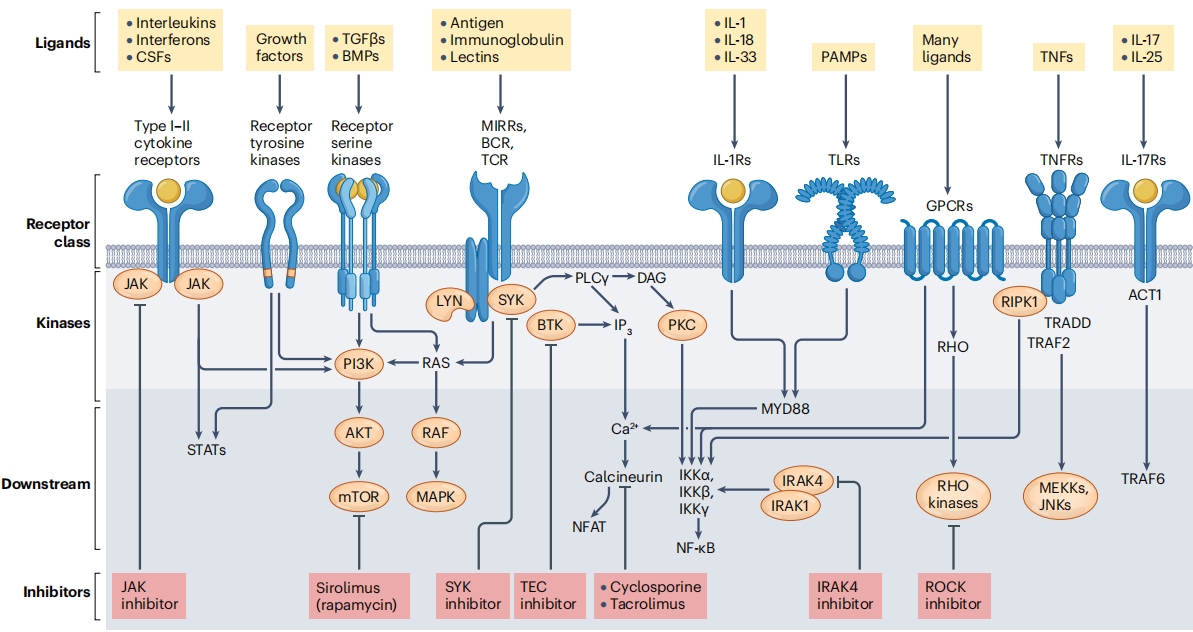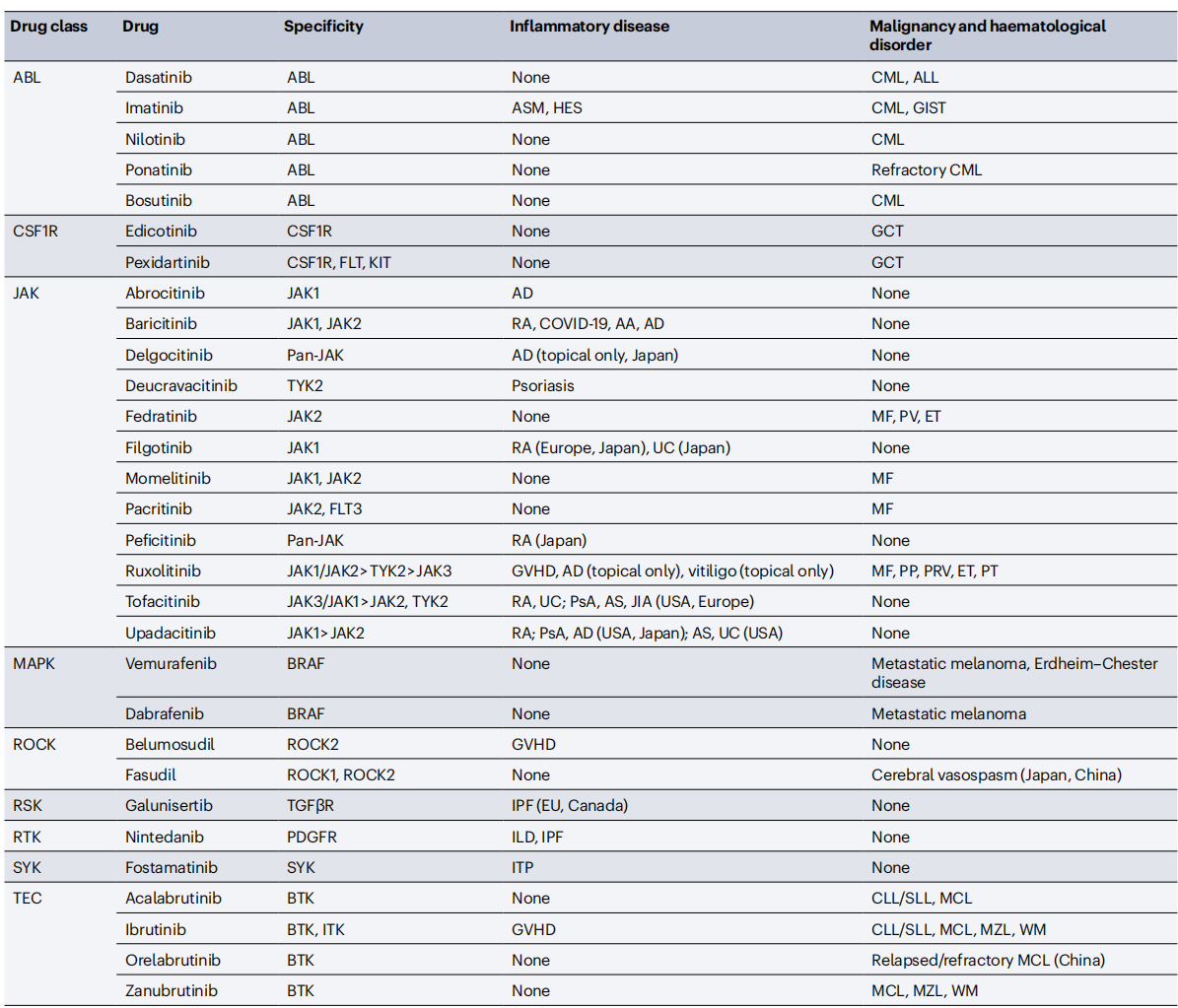From Bench to Bedside: Two Decades of Breakthroughs in Protein Kinase Drug Development

Introduction
Protein kinases play a pivotal role in cellular activation processes, particularly in signal transduction and immune responses. They regulate protein activity through phosphorylation, thereby influencing critical cellular processes such as growth, differentiation, metabolism, and apoptosis. Given their extensive involvement in cellular functions, especially their significant roles in immune-mediated diseases and cancer, protein kinases have emerged as crucial targets for drug development.
Protein kinases are enzymes that catalyze the phosphorylation of proteins, transferring the γ-phosphate group from ATP or GTP to the hydroxyl or phenolic hydroxyl groups of protein substrates, thereby altering their activity or function. Based on substrate amino acid residue preferences, protein kinases are classified into serine/threonine kinases, tyrosine kinases, and dual-specificity kinases (which can phosphorylate both serine/threonine and tyrosine residues). The human genome encodes over 518 protein kinases, accounting for 1.7% of all genes, making them central components of cellular signaling and regulation.
Role of Protein Kinases in Immune Cell Signal Transduction
Immune cells (e.g., T cells, B cells, and innate immune cells) express various cytokine receptors and immune recognition receptors, which initiate cellular activation through phosphorylation. Key kinases involved in immune cell signaling include receptor tyrosine kinases (RTKs), receptor serine kinases, non-receptor tyrosine kinases (e.g., Janus kinases [JAKs], SRC family kinases, SYK, and TEC family kinases), and downstream serine/threonine kinases. These kinases regulate immune cell activation and function through complex signaling networks.

Major Kinase Classes and Immune Receptor Signaling
Key immune receptors expressed by T cells, B cells, and innate immune cells include various cytokine receptors and multi-chain immune recognition receptors. Only a subset of downstream pathways is shown. Major kinases involved in immune receptor signaling include receptor tyrosine kinases, receptor serine kinases, non-receptor tyrosine kinases (e.g., Janus kinases [JAKs], SRC family kinases [e.g., LYN], SYK, and TEC family kinases [e.g., BTK]), and a broader group of downstream serine/threonine kinases.
JAK Family Kinase Inhibitors
Janus kinases (JAKs) are non-receptor tyrosine kinases that bind to cytokine receptors and phosphorylate these receptors as well as signal transducers and activators of transcription (STATs), thereby inducing gene expression. Due to their central role in cytokine signaling, JAK inhibitors have become effective treatments for various autoimmune and allergic diseases, as well as COVID-19. For example, JAK inhibitors such as tofacitinib and ruxolitinib have been approved for treating rheumatoid arthritis, psoriasis, and ulcerative colitis.
TEC Family Kinase Inhibitors
TEC family kinases (e.g., Bruton's tyrosine kinase [BTK]) play a critical role in antigen receptor signaling. BTK inhibitors such as ibrutinib have been approved for treating various hematologic malignancies and graft-versus-host disease (GVHD). These inhibitors block B cell receptor (BCR) signaling by inhibiting BTK phosphorylation, thereby suppressing B cell proliferation and activation.
ABL Kinase Inhibitors
The development of ABL kinase inhibitors marked an early milestone in kinase-targeted therapies. The first ABL kinase inhibitor, imatinib (Gleevec), was approved in the early 2000s for treating chronic myeloid leukemia (CML). Imatinib binds to and inhibits the kinase activity of the BCR-ABL fusion protein, significantly reducing the proportion of BCR-ABL cells in the bone marrow of CML patients and extending survival. However, resistance to imatinib has emerged in some patients, leading to the development of second-generation (e.g., nilotinib and dasatinib) and third-generation (e.g., ponatinib and bosutinib) ABL kinase inhibitors.
Decade of Protein Kinase Drugs
Approved Kinase Inhibitor Drugs for Inflammatory Diseases, Malignancies, and Hematologic Disorders

Abbreviations: AA, alopecia areata; AD, atopic dermatitis; ALL, acute lymphoblastic leukemia; AS, ankylosing spondylitis; ASM, advanced systemic mastocytosis; BTK, Bruton's tyrosine kinase; CLL, chronic lymphocytic leukemia; CML, chronic myeloid leukemia; CSF1R, colony-stimulating factor 1 receptor; ET, essential or post-essential thrombocythemia; GCT, giant cell tumor; GIST, gastrointestinal stromal tumor; GVHD, graft-versus-host disease; HES, hypereosinophilic syndrome; ILD, interstitial lung disease; IPF, idiopathic pulmonary fibrosis; ITP, idiopathic thrombocytopenic purpura; JAK, Janus kinase; JIA, juvenile idiopathic arthritis; MAPK, mitogen-activated protein kinase; MCL, mantle cell lymphoma; MF, myelofibrosis; MZL, marginal zone lymphoma; PDGFR, platelet-derived growth factor receptor; PP, primary polycythemia; PRV, polycythemia vera; PsA, psoriatic arthritis; PT, primary thrombocythemia; PV, pemphigus vulgaris; RA, rheumatoid arthritis; ROCK, Rho-associated coiled-coil protein kinase; RSK, receptor serine kinase; RTK, receptor tyrosine kinase; SLL, small lymphocytic leukemia; SYK, spleen tyrosine kinase; TGFβR, transforming growth factor-β receptor; UC, ulcerative colitis; WM, Waldenström's macroglobulinemia.
Conclusion
The indications for kinase drugs have expanded to include a wide range of diseases, such as immunosuppression, inflammation, autoimmune disorders, Alzheimer's disease, and Parkinson's disease. Over the next two decades, oncology will continue to dominate kinase drug discovery, with a focus on the tumor microenvironment and immune biology.
As our understanding of protein kinase function and regulation deepens, the development of novel kinase inhibitors will remain a major growth area. This includes the development of antibody-drug conjugates (ADCs) and bispecific antibodies targeting specific kinases, such as Johnson & Johnson's MET/EGFR bispecific antibody, amivantamab.
Approximately 30% of global pharmaceutical R&D expenditure is focused on kinase inhibitor development. The kinase therapy market is valued at around $20 billion annually and is expected to grow. To date, 208 protein kinase inhibitor drugs have been approved globally, with 120 in the registration phase, highlighting the robust growth in this field.
Product Information
| Gatalog Num | Product Name | Product Parameters | Price |
| UA080270 | BRAF GST Tag Protein | Host : Human | $767 |
| Expression System : Baculovirus-InsectCells | |||
| Conjugation : Unconjugated | |||
| UA080261 | BRAF Flag Tag Protein,Human | Host : Human | $320 |
| Expression System : E.coli | |||
| Conjugation : Unconjugated | |||
| UA080394 | ABL Protein, Human | Host : Human | $444 |
| Expression System : Baculovirus-InsectCells | |||
| Conjugation : Unconjugated | |||
| UA080048 | BTK[V416L] Protein | Host : Human | $1,152 |
| Expression System : Baculovirus-InsectCells | |||
| Conjugation : Unconjugated | |||
| UA080047 | BTK[T474S] Protein | Host : Human | $1,152 |
| Expression System : Baculovirus-InsectCells | |||
| Conjugation : Unconjugated | |||
| UA080046 | BTK[T474I] Protein | Host : Human | $1,152 |
| Expression System : Baculovirus-InsectCells | |||
| Conjugation : Unconjugated | |||
| UA080045 | BTK[T316A] Protein | Host : Human | $1,152 |
| Expression System : Baculovirus-InsectCells | |||
| Conjugation : Unconjugated | |||
| UA080044 | BTK[M437R] Protein | Host : Human | $1,152 |
| Expression System : Baculovirus-InsectCells | |||
| Conjugation : Unconjugated | |||
| UA080043 | BTK[C481S] Protein | Host : Human | $767 |
| Expression System : Baculovirus-InsectCells | |||
| Conjugation : Unconjugated | |||
| UA080042 | BTK[C481R] Protein | Host : Human | $1,152 |
| Expression System : Baculovirus-InsectCells | |||
| Conjugation : Unconjugated | |||
| UA080041 | BTK Protein | Host : Human | $767 |
| Expression System : Baculovirus-InsectCells | |||
| Conjugation : Unconjugated | |||
| UA080105 | JAK3(JH1) Protein | Host : Human | $767 |
| Expression System : Baculovirus-InsectCells | |||
| Conjugation : Unconjugated | |||
| UA080336 | JAK3 GST Tag Protein, Human | Host : Human | $444 |
| Expression System : Baculovirus-InsectCells | |||
| Conjugation : Unconjugated | |||
| UA080257 | JAK2(JH1 JH2) Protein | Host : Human | $767 |
| Expression System : Baculovirus-InsectCells | |||
| Conjugation : Unconjugated | |||
| UA080104 | JAK1(JH1) Protein | Host : Human | $767 |
| Expression System : Baculovirus-InsectCells | |||
| Conjugation : Unconjugated | |||
| UA080399 | Biotinylated JAK2 Protein, Human | Host : Human | $592 |
| Expression System : Baculovirus-InsectCells | |||
| Conjugation : Biotin |




